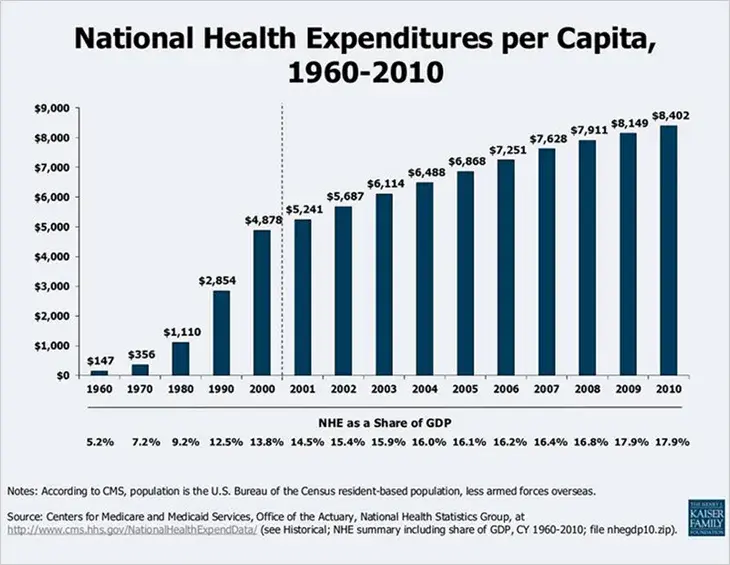Americans are paying much more for health care services than the average residents in most other developed countries. Infographics published by TIME Magazine recently gives a clear insight into the disproportionate rise in U.S. healthcare spending which is not reflected in the outcomes. The information is based on the data retrieved from several authoritative sources including the Centers for Medicare and Medicaid, International Federation of Health Plans, American Journal of Medicine and so on and Steven Brill’s article ‘Bitter Pill: Why Medical Bills Are Killing Us’ published in an earlier issue of TIME Magazine.
The following graph from the Kaiser Family Foundation shows the increase in national health expenditures per capita during 1960-2010:
It is estimated that the likely cost of health care in U.S in 2013 is $2.8 trillion in 2013. After adjusting for relative income and cost of living, the U.S. spends an additional $750 billion annually for health care compared to other developed nations. National health expenditure rose five times more than GDP between 1990 and 2010. Making the picture even more dismal is the fact that this spending is not reflected in the outcomes, which are poorer than in other countries. The annual health care spending in U.S during 2010 for a person was $8000 and the life expectancy at birth, 79 years. At the same time, the annual health care spending in Japan is just the half of that in the U.S. while life expectancy is 83 years.
Rather than generating outcomes, high healthcare bills are causing bankruptcy. Around 62% of bankruptcies filed in U.S are related to illness or medical bills and 69% of them were insured at the time of filing. In June, a CNBC report had said that bankruptcies caused by unpaid medical bills would affect nearly 2 million people in 2013.
Among the major reasons for this crisis are skyrocketing procedure costs and drug prices. The average cost for a CT scan (head) is $78 in Argentina, while in U.S. it is $510. The price of a Liptor pill in U.S. is three time higher than in Argentina. As technology advanced, outpatient services increased dramatically and with this, the demand for more procedures. Another reason is the heavy lobbying prevalent in the health care industry. Billions are also being spent on lobbying Congress, and pharmaceutical and healthcare products and organizations representing doctors, hospitals and insurers. Steven Brill’s research found that even top-rated nonprofit healthcare centers have medical billing and collection practices that rake in massive profits.
The nation is in urgent need of an effective solution for rising health care costs. However, adopting the kind of health care system in other comparable countries is not at a viable solution. Brill offers the following suggestions that would help the U.S. offer better care at lower costs:
- Restrict the prices of prescription drugs which cover 10% of health care costs and are 50% higher than in other countries. This can bring in savings of about $94 billion.
- Tax hospital profits at 75% and have a tax surcharge on all non-doctor hospital salaries that exceed for instance $750,000 for savings of about $84 billion annually.
- Reduce drugmakers’ prices on par with what is paid in other developed countries for savings of over $90 billion a year.
- By cutting the spending on outpatient clinics and labs managed by doctors through regulating fees or imposing tax on profits, $50 billion can be saved
- The Affordable Care Act includes a 2.3% tax on medical devices which will bring down the profits of medical – device makers and save $30 billion.
- Encourage comparative – effectiveness evaluation while making the decision to prescribe drugs, tests and medical equipment, which will save up to $28 billion.
Even though these suggestions are laudable, the co – operation of health care providers, insurers, patients and regulatory bodies are essential to implement them. Unless there is a system that considers the concerns of players in the health care system is in place, it is nearly impossible to control rising costs.




